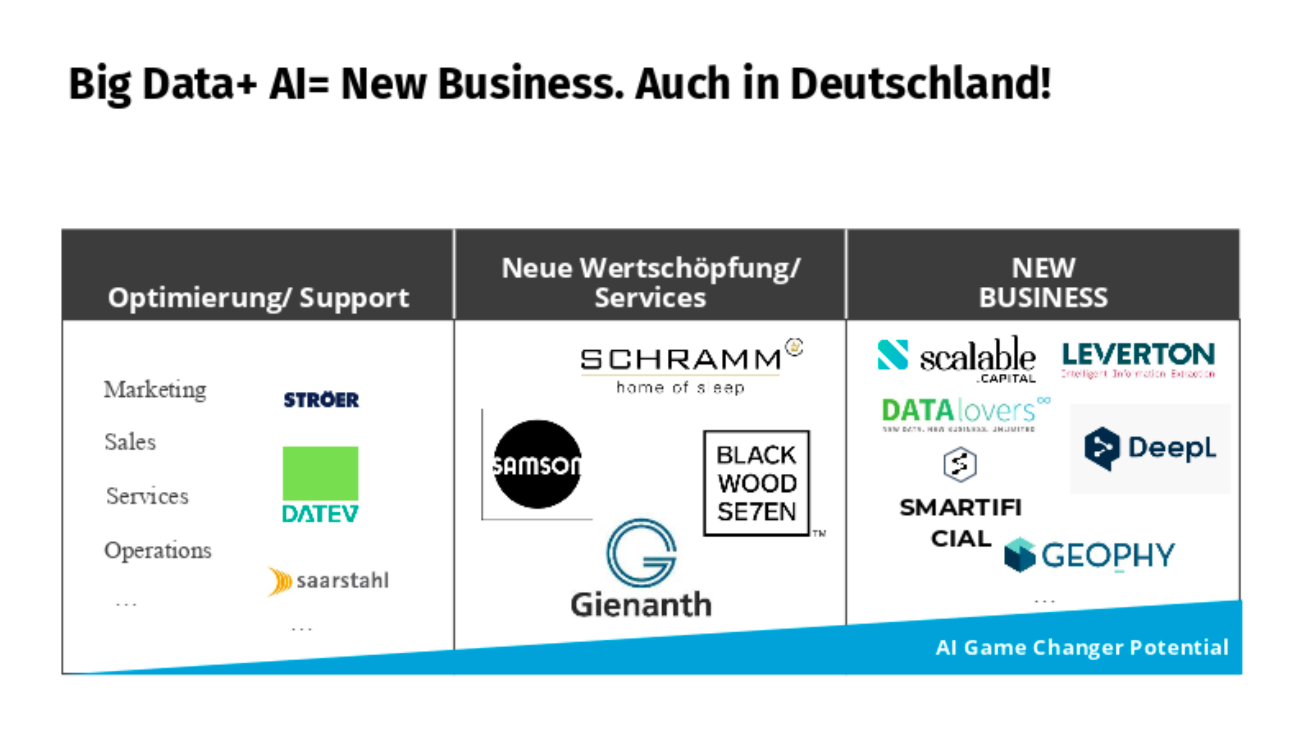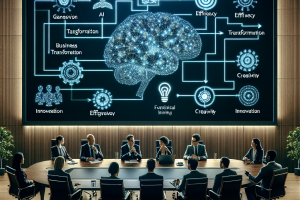FROM PROF. DR. PETER GENTSCH
-
Artificial intelligence enables increased efficiency, cost reduction and sales growth
-
Artificial intelligence enables digital business models
-
Artificial intelligence enables data-driven growth hacking
-
Artificial intelligence can open up new markets and customer groups
-
Artificial intelligence can be divided into the categories Business Centric AI, Consumer AI, Perception-AI and Autonomous-AI
-
Business Centric AI is a promising approach especially for German companies
-
Best practices from Ströer, DeepL, Leverton and DATAlovers show the immense business potential of Business Centric AI
AI and Smart Data should not only be understood as a technology for the optimization and automation of individual functions, but as “business boosters” for existing and new business models. And this is exactly where companies have a certain lack of imagination. The focus is more on engineering-like optimization and less on monetization through new business areas and models. The market capitalization of the GAFA and BAT worlds impressively demonstrate the economic potential of data and AI driven platforms. The fact that SAP is now listed as the only German company among the top 100 companies worldwide underlines the negative trend.
BUSINESS-CENTRIC AI AS AN OPPORTUNITY
Yet there is hope! The battle for the “consumer Internet AI” has long been lost against Google, Facebook, Baidu, Alibaba and Co. Nobody knows the consumer as well as the American and Chinese platforms, BUT how companies work (and especially company data) we know much better in Europe (long history of ERP and automation). The AI battles in the areas of “Perception AI” (speech and image recognition, …) and “Autonomous AI” (self-propelled cars, …) will probably not be easy to win either.
BEST & NEXT PRACTICES
In the area of “Business AI”, however, Germany has considerable potential to bring AI-PS onto the road against the background of Industry 4.0, IoT and the successful hidden champions. And the good news is that we already have successful examples of this in Germany:

SMEs in particular have a lot of industry experience. If this experience is supported and automated by AI systems, companies have more resources to focus on innovation and service as a competitive advantage (Level I). Thus Ströer has automated and optimized its marketing and sales processes with AI. The time thus gained can be used, for example, for personal customer contact.
Existing business models must be checked and questioned against the AI and Smart Data background. As a result, business areas can be expanded or new business areas can be developed (Level II). Gienanth, one of the largest foundries in Germany is currently testing the AI-based calculation of cast products. Up to now this has been an elaborate process that requires a lot of expert knowledge. The AI is now learning this knowledge from experience so that calculations can be made at the push of a button. However, this approach should not remain on the level of automation (Level I).
The idea is to make this AI-based calculation available to other companies as an SaaS service. A bidder auction platform for tenders for casting projects is also conceivable. Gienanth can thus expand its existing core business to further business areas. The start-up DATAlovers (datalovers.com) uses AI and web data to automatically calculate company scores (creditworthiness, digital index, performance score, …). This company would not exist without the possibilities of AI and Smart Web data. In addition to the design and optimization of corporate functions and processes, algorithms and AI thus also have the potential to question and reinvent business models.
For example, Netflix owes its current success to the fundamental disruption of its business model from a mail order company to an on-demand streaming portal. As a result, the company has quickly moved from the bottom end of the market to the global leader – ahead of the streaming portal of giant Amazon. In addition to its own serial productions, Netflix was able to assert itself above all through its specially developed AI, which guarantees maximum, dynamically adapted streaming quality, even with very low Internet bandwidth. Thus the company was able to assert itself and establish itself at the top even in markets with rather underdeveloped infrastructure.
Likewise, the agile start-up AirBnb is already threatening traditional industry leaders like Marriott. Started as an idea for an inexpensive solution for budget travelers with an air mattress in other people’s living rooms, luxury apartments can now be booked via the portal. The innovative pricing algorithm set new standards. With the help of a trained deep-learning network, factors such as location, facilities, demand, but also the presentation of the offer in real time are weighted individually for each customer. The system thus calculates a price tip for the hosts. The financial services sector is also repositioning itself. Recently, for example, the expanding and critically discussed start-up company Kredittech has been stirring up the market. Based on Big Data, it calculates a scoring of consumer creditworthiness with a precision and duration that would be unthinkable in the conventional way.
This enables creditors to minimize their risk of payment defaults, and customers receive an acceptance or rejection of their credit application much faster. The B2B sector also responds with corresponding AI-as-a-services. For example, a digital, synthetic credit score can be calculated automatically based on Big Data and AI. Robo Advisor offers such as Scalable Capital in investment consulting or App clark.de in insurance consulting and management are also booming. The customer is informed about the latest market developments in real time and can react.
The offer can be tailored precisely to the customer’s needs, and the accessibility of the offers through mobile smartphone apps or Internet portals cannot be compared with a local advisor. Figure 5.3 shows some examples of different application motives and perspectives of AI. In the data economy, data also plays a central role as a source of expanded or new business models. The following figure provides a list of questions to explore the potential of data for extended and new business models:
Consideration must be given to whether existing data can be used to expand the business model or can be monetised in the form of sales to other companies. On the other hand, it must also be examined in terms of evaluating possible threat potential whether competitors may possess data that pose a threat to their own business model.



